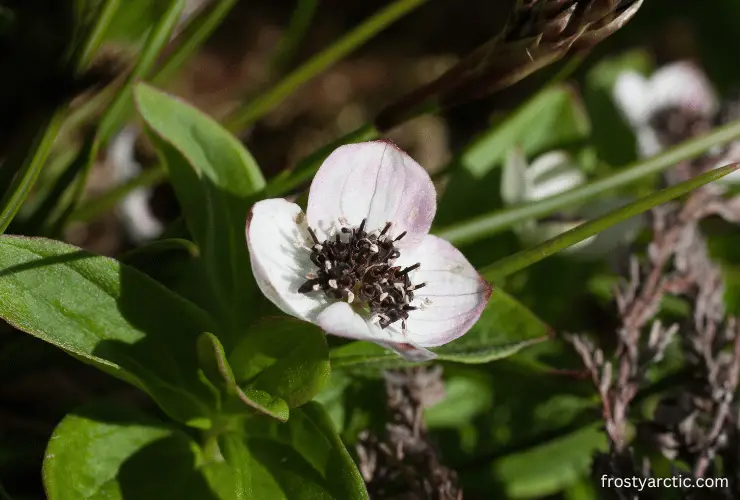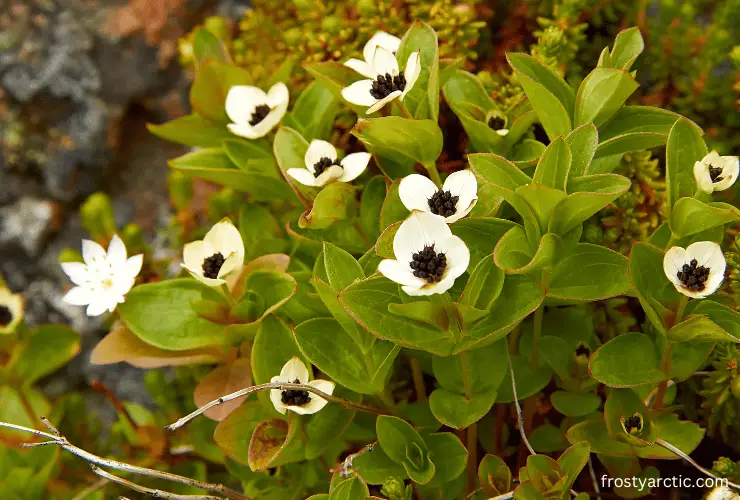Dwarf Cornel is an evergreen flowering plant that is often found in Subarctic regions. Alaska and Greenland are the regions where Dwarf Cornel is mostly famous. This plant contains beautiful white flowers as well as edible fruits. However, spring is the flowering time of Cornus suecica.
Today, I will be discussing every detail of this fascinating plant. Besides, I will share details on the growth conditions and propagation methods. If you are wondering about its medicinal uses or want to grow it at home, then stay tuned till the end.
Dwarf Cornel at a Glance
| Parameters | Description |
| Scientific name | Cornus suecica |
| Plant type | Perennial |
| Plant size | 10-25 cm |
| Leaf size | 2-4 cm |
| Width | 1-3 cm |
| Soil condition | Acidic and wet |
| Watering | Occasionally |
| Sun exposure | Full, semi-shade |
| Leaf color | Green |
| Flower color | White |
| Blooming season | June-July |
| Toxicity | No |
What Is a Dwarf Cornel?
Dwarf Cornel is a type of perennial flowering plant that is usually found in Cool temperature zones. The scientific name of Dwarf Cornel is Cornus Suecica, and it belongs to the Cornaceae family, also known as the dogwood family.
The plant is small in size and grows from a perennial herb. Mainly, the height of the plant ranges between 10-25 cm. In many areas, dwarf cornel is also known as bunchberry.
Also, the plant contains beautiful white flowers. Normally, the flowers bloom in June-July. However, at the end of the growing season, the color turns red or purplish brown.
Why Is It Called Dwarf Cornel?
The term ‘Dwarf’ came from the height of this flowering plant. Dwarf means small in size, and this plant’s height is also small compared to other flowering plants. The maximum height they can reach is 25 cm. For this reason, the term dwarf came to its name.
The term ‘Cornel’ means a shrub or herb that belongs to the dogwood family and genus Cornus. And this plant belongs to a similar family and genus. These are the motivations behind Dwarf Cornel’s name.
Where Does Dwarf Cornel Grow?
The dwarf cornel loves to grow in cool temperatures with sunlight. The bright, sunny place maximizes the growth rate of this plant. As a result, they are mostly found in moorland and mountains.

Moreover, dwarf cornel is native to Europe and Asia’s subarctic regions. But in the continental centers of Asia, they are not present. Alaska, eastern Canada, and Greenland are the common places in North America where Dwarf Cornel is mostly found.
Dwarf Cornel Adaptations
Dwarf Cornel adapts to his surroundings through a variety of means, including:
- Small height: Thesmall height is beneficial for survival from the wind. They can withstand heavy winds.
- Specialized Root: The root of the plant absorbs essential nutrients from the soil.
- Green leaves: The green leaves absorb moisture from the environment as well as constantly run the photosynthesis process for the production of food.
How Much Sun Does Dwarf Cornel Need?
Though Dwarf Cornel loves cool temperatures, it also needs sunny places for better growth. However, they can grow in semi-shaded places, too. However, placing it in a bright location will increase the plant’s potential for growth.

This plant cannot grow in areas where sunlight cannot reach. They won’t have enough sunlight for their photosynthesis. As a result, they won’t get sufficient nutrients for proper growth. They might grow poorly or may not grow at all in shaded places.
In the presence of sunlight, this plant can produce its food through photosynthesis and meet the need for essential nutrients. Therefore, bright places with sunlight are preferable for Cornel the dwarf Cornel.
How Does Dwarf Cornel Reproduce?
Dwarf cornel is mostly propagated by seeds. It is best seeded in a cold frame as soon as it is ready, or if there is enough seed, in an outdoor seedbed. The fruit flesh must be removed from the seed because it contains germination inhibitors.
Germination might take up to 18 months, especially when a stored seed is involved. When the seedlings of cold-frame sown seeds are big enough to handle, prick them out into individual pots and grow the plants for their first winter in a greenhouse. Then, plant them outside in the spring after the last anticipated frost.
Lastly, pot them in a greenhouse, in light shade, and ensure they are not dried. Maybe it will take 12 months to root well. After this, they can be planted in permanent places.
Is Dwarf Cornel Edible?
Yes, Dwarf Cornel is edible. Dwarf cornel contains fruits that you can eat separately or mixed with others. Besides, you can eat the fruits in raw condition as well as by cooking. Usually, the fruits are mixed with other berries when consumed.
Though they are edible, people don’t include them in their diet. They are rich in pectin content, which may cause minor diarrhea or gas if taken in large amounts. However, the stems and leaves can be used as food flavors, mostly in tea and other drinks.
Dwarf Cornel Taste
The edible fruits do not taste good. It tastes slightly bitter. People generally do not include this in their diets because of the taste. The stems of the plants have a woody flavor.

However, animals love to eat fruits. Though it tastes bitter to us, it tastes good to some animals, especially birds.
Dwarf Cornel Uses
Dwarf Cornel can be used in many ways, including as food and medicine. Besides, people use it to increase the beauty of their gardens. As the fruits do not taste good, people avoid including this plant in their diet. But some animals and birds use it as a food source.
What Animals Eat Dwarf Cornel?
Interestingly, some animals tend to like the bitter taste of the Dwarf Cornel. Mostly, birds eat the fruits of this plant. Therefore, if you plant Dwarf Cornel in your garden, then it will attract some birds.
What Did Native Americans Use Dwarf Cornel For?
The Native Americans were the first to use it as a food source. The fruits of the plants were eaten by most of the native Americans due to their nutritional value. They also used it as medicine for some diseases.
The dead plants were collected and dried in the sunlight for further use as fuel. They are also used to eat the flowers and leaves by cooking them in water or other foods.
Is Dwarf Cornel a Medicinal Plant? Medicinal Use of Dwarf Cornel
Yes, Dwarf Cornel is a medicinal plant. But there is no widespread use of this plant. The fruits have some nutritional content that can treat diseases like dysentery and diarrhea.
Before treating diarrhea, the fruits should be mixed with other contents like pears and nutshells, or they can worsen the situation.
Some parts of the plant contain astringent properties because they contain tannins. For this reason, the parts are used for treating skin problems as well as those in other body tissues.
FAQs
Can you grow Dwarf Cornel at home?
Yes, you can grow Dwarf Cornel at home. The plant likes to grow in acidic soil. You have to choose a place where the soil is acidic and the sunlight is available. Regular watering and care will increase the growth rate.
How much water does Dwarf Cornel need?
Dwarf cornel doesn’t need regular watering. If you potted the plant into a 5-inch pot, then the plant needs 0.8 cups of water per 9 days. This condition is required if there is no direct sunlight.
What is Dwarf Cornel good for?
Dwarf cornel is best for increasing the beauty of a garden. Though they have many medical and food uses, they are used mostly for their beauty. But you should be aware of birds, as they love to eat Dwarf Cornel.
Conclusion
Dwarf Cornel is an infamous evergreen plant. The specialty of this plant is the beauty of the flowers. It attracts humans and animals with its white and green combination of colors. The plant is not poisonous but also doesn’t contain sufficient content for human use. You can grow the plant beside your home by choosing suitable soil and sunlight conditions.


